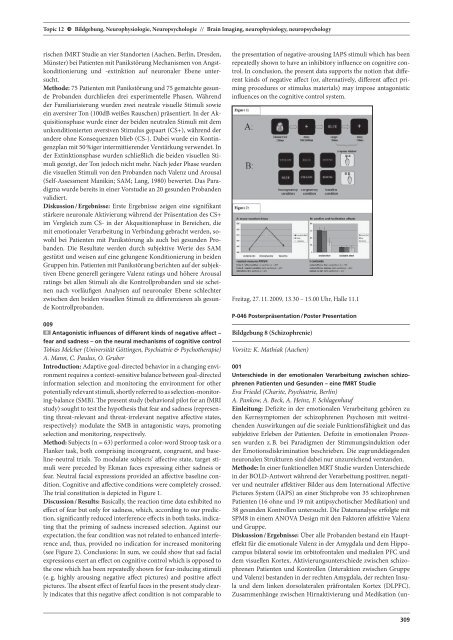Psychische Erkrankungen in der Lebensspanne ... - DGPPN
Psychische Erkrankungen in der Lebensspanne ... - DGPPN
Psychische Erkrankungen in der Lebensspanne ... - DGPPN
Erfolgreiche ePaper selbst erstellen
Machen Sie aus Ihren PDF Publikationen ein blätterbares Flipbook mit unserer einzigartigen Google optimierten e-Paper Software.
Topic 12 G Bildgebung, Neurophysiologie, Neuropsychologie // Bra<strong>in</strong> Imag<strong>in</strong>g, neurophysiology, neuropsychology<br />
rischen fMRT Studie an vier Standorten (Aachen, Berl<strong>in</strong>, Dresden,<br />
Münster) bei Patienten mit Panikstörung Mechanismen von Angstkonditionierung<br />
und -ext<strong>in</strong>ktion auf neuronaler Ebene untersucht.<br />
Methode: 75 Patienten mit Panikstörung und 75 gematchte gesunde<br />
Probanden durchliefen drei experimentelle Phasen. Während<br />
<strong>der</strong> Familiarisierung wurden zwei neutrale visuelle Stimuli sowie<br />
e<strong>in</strong> aversiver Ton (100dB weißes Rauschen) präsentiert. In <strong>der</strong> Akquisitionsphase<br />
wurde e<strong>in</strong>er <strong>der</strong> beiden neutralen Stimuli mit dem<br />
unkonditionierten aversiven Stimulus gepaart (CS+), während <strong>der</strong><br />
an<strong>der</strong>e ohne Konsequenzen blieb (CS-). Dabei wurde e<strong>in</strong> Kont<strong>in</strong>genzplan<br />
mit 50 %iger <strong>in</strong>termittieren<strong>der</strong> Verstärkung verwendet. In<br />
<strong>der</strong> Ext<strong>in</strong>ktionsphase wurden schließlich die beiden visuellen Stimuli<br />
gezeigt, <strong>der</strong> Ton jedoch nicht mehr. Nach je<strong>der</strong> Phase wurden<br />
die visuellen Stimuli von den Probanden nach Valenz und Arousal<br />
(Self-Assessment Manik<strong>in</strong>; SAM; Lang, 1980) bewertet. Das Paradigma<br />
wurde bereits <strong>in</strong> e<strong>in</strong>er Vorstudie an 20 gesunden Probanden<br />
validiert.<br />
Diskussion / Ergebnisse: Erste Ergebnisse zeigen e<strong>in</strong>e signifikant<br />
stärkere neuronale Aktivierung während <strong>der</strong> Präsentation des CS+<br />
im Vergleich zum CS- <strong>in</strong> <strong>der</strong> Akqusitionsphase <strong>in</strong> Bereichen, die<br />
mit emotionaler Verarbeitung <strong>in</strong> Verb<strong>in</strong>dung gebracht werden, sowohl<br />
bei Patienten mit Panikstörung als auch bei gesunden Probanden.<br />
Die Resultate werden durch subjektive Werte des SAM<br />
gestützt und weisen auf e<strong>in</strong>e gelungene Konditionierung <strong>in</strong> beiden<br />
Gruppen h<strong>in</strong>. Patienten mit Panikstörung berichten auf <strong>der</strong> subjektiven<br />
Ebene generell ger<strong>in</strong>gere Valenz rat<strong>in</strong>gs und höhere Arousal<br />
rat<strong>in</strong>gs bei allen Stimuli als die Kontrollprobanden und sie sche<strong>in</strong>en<br />
nach vorläufigen Analysen auf neuronaler Ebene schlechter<br />
zwischen den beiden visuellen Stimuli zu differenzieren als gesunde<br />
Kontrollprobanden.<br />
009<br />
Antagonistic <strong>in</strong>fluences of different k<strong>in</strong>ds of negative affect –<br />
fear and sadness – on the neural mechanisms of cognitive control<br />
Tobias Melcher (Universität Gött<strong>in</strong>gen, Psychiatrie & Psychotherapie)<br />
A. Mann, C. Paulus, O. Gruber<br />
Introduction: Adaptive goal-directed behavior <strong>in</strong> a chang<strong>in</strong>g environment<br />
requires a context-sensitive balance between goal-directed<br />
<strong>in</strong>formation selection and monitor<strong>in</strong>g the environment for other<br />
potentially relevant stimuli, shortly referred to as selection-monitor<strong>in</strong>g-balance<br />
(SMB). The present study (behavioral pilot for an fMRI<br />
study) sought to test the hypothesis that fear and sadness (represent<strong>in</strong>g<br />
threat-relevant and threat-irrelevant negative affective states,<br />
respectively) modulate the SMB <strong>in</strong> antagonistic ways, promot<strong>in</strong>g<br />
selection and monitor<strong>in</strong>g, respectively.<br />
Method: Subjects (n = 63) performed a color-word Stroop task or a<br />
Flanker task, both compris<strong>in</strong>g <strong>in</strong>congruent, congruent, and basel<strong>in</strong>e-neutral<br />
trials. To modulate subjects’ affective state, target stimuli<br />
were preceded by Ekman faces express<strong>in</strong>g either sadness or<br />
fear. Neutral facial expressions provided an affective basel<strong>in</strong>e condition.<br />
Cognitive and affective conditions were completely crossed.<br />
The trial constitution is depicted <strong>in</strong> Figure 1.<br />
Discussion / Results: Basically, the reaction time data exhibited no<br />
effect of fear but only for sadness, which, accord<strong>in</strong>g to our prediction,<br />
significantly reduced <strong>in</strong>terference effects <strong>in</strong> both tasks, <strong>in</strong>dicat<strong>in</strong>g<br />
that the prim<strong>in</strong>g of sadness <strong>in</strong>creased selection. Aga<strong>in</strong>st our<br />
expectation, the fear condition was not related to enhanced <strong>in</strong>terference<br />
and, thus, provided no <strong>in</strong>dication for <strong>in</strong>creased monitor<strong>in</strong>g<br />
(see Figure 2). Conclusions: In sum, we could show that sad facial<br />
expressions exert an effect on cognitive control which is opposed to<br />
the one which has been repeatedly shown for fear-<strong>in</strong>duc<strong>in</strong>g stimuli<br />
(e. g. highly arous<strong>in</strong>g negative affect pictures) and positive affect<br />
pictures. The absent effect of fearful faces <strong>in</strong> the present study clearly<br />
<strong>in</strong>dicates that this negative affect condition is not comparable to<br />
the presentation of negative-arous<strong>in</strong>g IAPS stimuli which has been<br />
repeatedly shown to have an <strong>in</strong>hibitory <strong>in</strong>fluence on cognitive control.<br />
In conclusion, the present data supports the notion that different<br />
k<strong>in</strong>ds of negative affect (or, alternatively, different affect prim<strong>in</strong>g<br />
procedures or stimulus materials) may impose antagonistic<br />
<strong>in</strong>fluences on the cognitive control system.<br />
Freitag, 27. 11. 2009, 13.30 – 15.00 Uhr, Halle 11.1<br />
P-046 Posterpräsentation / Poster Presentation<br />
Bildgebung 8 (Schizophrenie)<br />
Vorsitz: K. Mathiak (Aachen)<br />
001<br />
Unterschiede <strong>in</strong> <strong>der</strong> emotionalen Verarbeitung zwischen schizophrenen<br />
Patienten und Gesunden – e<strong>in</strong>e fMRT Studie<br />
Eva Friedel (Charite, Psychiatrie, Berl<strong>in</strong>)<br />
A. Pankow, A. Beck, A. He<strong>in</strong>z, F. Schlagenhauf<br />
E<strong>in</strong>leitung: Defizite <strong>in</strong> <strong>der</strong> emotionalen Verarbeitung gehören zu<br />
den Kernsymptomen <strong>der</strong> schizophrenen Psychosen mit weitreichenden<br />
Auswirkungen auf die soziale Funktionsfähigkeit und das<br />
subjektive Erleben <strong>der</strong> Patienten. Defizite <strong>in</strong> emotionalen Prozessen<br />
wurden z. B. bei Paradigmen <strong>der</strong> Stimmungs<strong>in</strong>duktion o<strong>der</strong><br />
<strong>der</strong> Emotionsdiskrim<strong>in</strong>ation beschrieben. Die zugrundeliegenden<br />
neuronalen Strukturen s<strong>in</strong>d dabei nur unzureichend verstanden.<br />
Methode: In e<strong>in</strong>er funktionellen MRT Studie wurden Unterschiede<br />
<strong>in</strong> <strong>der</strong> BOLD-Antwort während <strong>der</strong> Verarbeitung positiver, negativer<br />
und neutraler affektiver Bil<strong>der</strong> aus dem International Affective<br />
Pictures System (IAPS) an e<strong>in</strong>er Stichprobe von 35 schizophrenen<br />
Patienten (16 ohne und 19 mit antipsychotischer Medikation) und<br />
38 gesunden Kontrollen untersucht. Die Datenanalyse erfolgte mit<br />
SPM8 <strong>in</strong> e<strong>in</strong>em ANOVA Design mit den Faktoren affektive Valenz<br />
und Gruppe.<br />
Diskussion / Ergebnisse: Über alle Probanden bestand e<strong>in</strong> Haupteffekt<br />
für die emotionale Valenz <strong>in</strong> <strong>der</strong> Amygdala und dem Hippocampus<br />
bilateral sowie im orbitofrontalen und medialen PFC und<br />
dem visuellen Kortex. Aktivierungsunterschiede zwischen schizophrenen<br />
Patienten und Kontrollen (Interaktion zwischen Gruppe<br />
und Valenz) bestanden <strong>in</strong> <strong>der</strong> rechten Amygdala, <strong>der</strong> rechten Insula<br />
und dem l<strong>in</strong>ken dorsolateralen präfrontalen Kortex (DLPFC).<br />
Zusammenhänge zwischen Hirnaktivierung und Medikation (un-<br />
309


